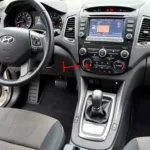The OBD2 open end protocol, also known as OBD2 mode 2, is a critical function within your vehicle’s onboard diagnostics system. It allows you to access freeze frame data, a snapshot of your engine’s performance at the time a fault code was triggered. This data can be invaluable for diagnosing and repairing car problems, offering deeper insights than just the error code itself.
Delving into OBD2 Freeze Frame Data
Imagine this: your check engine light illuminates, indicating an issue. While the OBD2 error code can pinpoint the general problem area, freeze frame data provides the context. It records various parameters like engine speed, coolant temperature, vehicle speed, and more, taken at the exact moment the fault occurred.
By analyzing this snapshot, mechanics and car enthusiasts can gain valuable insights into the potential causes of the issue. For instance, high RPMs coupled with low vehicle speed might point towards a transmission problem, while high coolant temperature could indicate a failing thermostat.
Accessing Freeze Frame Data with an OBD2 Scanner
Accessing this treasure trove of information requires an OBD2 scanner, a handheld device that connects to your vehicle’s OBD2 port. However, not all scanners are created equal. Some basic models might only read error codes, while more advanced versions can retrieve freeze frame data and offer additional diagnostic capabilities.
When choosing an OBD2 scanner, consider your needs and budget. If you’re a car enthusiast who enjoys DIY repairs, investing in a scanner that can access freeze frame data can be incredibly beneficial.
Benefits of Utilizing Freeze Frame Data
The advantages of utilizing freeze frame data extend beyond just identifying car problems. Here’s why it’s a powerful tool:
- Accurate Diagnosis: Provides a more accurate diagnosis compared to relying solely on error codes.
- Faster Repairs: Helps mechanics identify the root cause faster, leading to quicker repairs.
- Cost Savings: Can potentially save money by avoiding unnecessary part replacements.
- Preventive Maintenance: By analyzing trends in freeze frame data over time, you can identify potential issues before they escalate.
Real-World Applications of OBD2 Open End Protocol
Let’s explore some scenarios where the OBD2 open end protocol and freeze frame data prove invaluable:
- Intermittent Problems: For issues that occur sporadically, freeze frame data can help pinpoint the cause even when the problem isn’t currently present.
- Sensor Malfunctions: By analyzing sensor readings in the freeze frame, you can determine if a sensor is faulty and needs replacement.
- Performance Issues: If you’re experiencing performance issues like rough idling or hesitation, freeze frame data can provide clues to fuel/air mixture problems or ignition timing issues.
Choosing the Right OBD2 Scanner for Freeze Frame Data
When selecting an OBD2 scanner with freeze frame data capabilities, consider the following:
- Compatibility: Ensure the scanner is compatible with your vehicle’s make, model, and year.
- Features: Look for features like live data streaming, graphing capabilities, and the ability to clear error codes.
- User Interface: Opt for a scanner with a user-friendly interface and clear display.
You can find more information about specific OBD2 scanner features in our articles about OBD2 scanner application and OBD2 scanners with EPB service mode.
Conclusion
The OBD2 open end protocol, with its ability to access freeze frame data, is an essential tool for anyone involved in vehicle diagnostics and repair. It offers a deeper understanding of your vehicle’s health and can save time and money by enabling faster and more accurate diagnoses. Whether you’re a professional mechanic or a DIY enthusiast, understanding and utilizing freeze frame data can significantly enhance your car maintenance experience.
If you’re looking for specific OBD2 codes for your BMW E46, you can find them here: BMW E46 OBD2 codes. We also have a detailed article on the common issue of the BMW E46 OBD2 code 492: BMW E46 OBD2 492.
For those interested in Honda vehicles, we have a helpful guide on Honda OBD2 TPS wiring: Honda OBD2 TPS Wiring.


